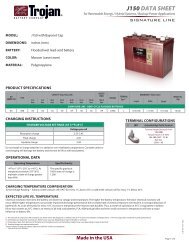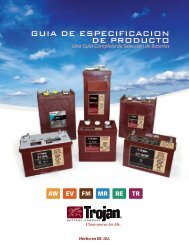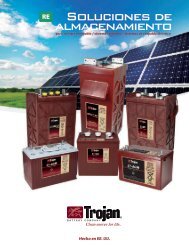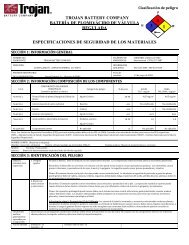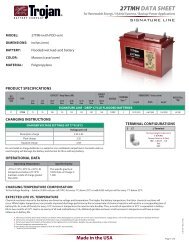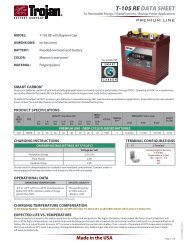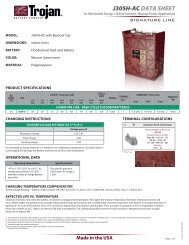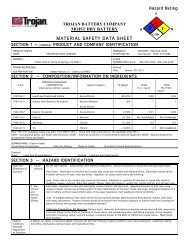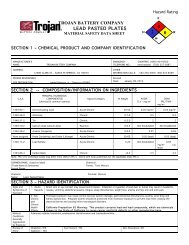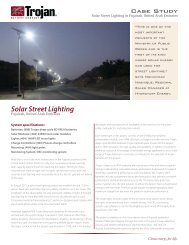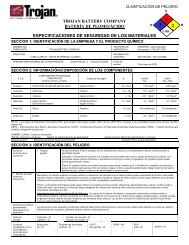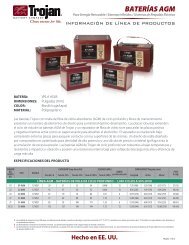PDF Page - Trojan Battery Company
PDF Page - Trojan Battery Company
PDF Page - Trojan Battery Company
Create successful ePaper yourself
Turn your PDF publications into a flip-book with our unique Google optimized e-Paper software.
CHOOSING THE RIGHT BATTERYTHE IMPORTANCE OF TESTING PV BATTERIES TO THE IEC 61427 STANDARDBACKGROUNDBatteries in photovoltaic systems (PV) are unique in how they are usedbecause recharging them is primarily dependent on the vagaries of theweather, and proper charging is crucial to getting the most life from adeep-cycle battery. In addition, experience has shown that batteries inPV systems are routinely undersized either due to cost considerations orbecause the loads were underestimated for the system.As a result, life expectancy of PV batteries is difficult to quantify – untilnow. The International Electrotechnical Commission’s (IEC) standard61427 titled Secondary cells and batteries for photovoltaic energy systems(PVES) – General requirements and methods of test provides performancecriteria that all batteries for PV applications can and should be measuredagainst. It offers a common, internationally-accepted platform tocompare and contrast batteries from different manufacturers.DEFINING BATTERY LIFE EXPECTANCY IN A PV SYSTEMTraditionally battery life has always been defined either as float life(how many years it takes the battery to reach end of life at a specifiedreference temperature) or as cycle life (the number of times a battery canbe continuously charged and discharged before it reaches end of life.) Itis worth examining in more detail what is meant by float life and cyclelife of a battery.In a float application, the battery is simply a source of backup power,such as in an uninterruptible power supply (UPS) system. In a UPSsystem, the traditional AC grid provides the power, but in the unlikelyevent of a grid failure the battery kicks in to power essential loads untilpower is restored from the grid. Until a grid failure occurs, the battery iskept on a continuous float (or trickle) charge, which can last for years at atime depending on the overall reliability of the AC grid.Therefore, in a float application, the battery is not charged anddischarged on a regular basis. In other words, a battery is not cycled ina float application. A battery is said to be cycled when it is repetitivelycharged and discharged in succession.In each case, to express a battery’s life expectancy, the underlyingassumption is that any particular application can be unambiguously seenas being either a float or cycling application. However, the reality is thatrenewable energy (RE) applications such as PV power systems are deepcyclingapplications, although there is an emerging trend for backuppower that requires the batteries to be in a hybrid mode. This placesbatteries somewhere between true float and true cycling applications.Since neither float life nor cycle life adequately describes the expectedlife of a battery in a RE application, an alternate method is needed tospecify battery life in a PV system, and the IEC 61427 standard offersa possible way to do that. This standard test protocol uses elevatedtemperature (40°C or 104°F) and a series of shallow cycles to simulate areal-world PV application. The battery being tested is considered to havereached end of life when its capacity drops to less than 80% of its ratedcapacity 1 .CAN PUBLISHED CYCLE LIFE CHARTS BE USED TOESTIMATE PV BATTERY LIFE?Deep-cycle battery manufacturers publish cycle life charts that showthe relationship between depth of discharge (DOD) and the number ofcycles delivered by the battery. To generate these charts the batteriesare charged and discharged (cycled) continuously in a laboratory undercontrolled conditions. These controlled charge and discharge conditionsensure that the batteries are never undercharged or overcharged; nor arethe batteries cycled at partial states of charge (PSOC), a situation that isvery common in a PV application. Since predictable charge or dischargerarely occur in a PV system, estimating the life of a PV battery using atypical cycle life chart is discouraged as it will not be representative of afield situation.While the cycle life chart found in a manufacturer’s literature does anadequate job of predicting the cycle life of a battery in a normal cyclingapplication 2 , it is not nearly as effective in estimating battery life in a PVapplication because of the various uncertainties associated with a PVsystem. The logical question that now arises is this: If neither float life norcycle life applies to a PV battery, how should one go about estimatingits life?In this paper we will use the term service life to refer to the life ofa battery in a PV application. We will define the service life of a PVbattery to be the number of cycles the battery delivers when testedto the IEC 61427 standard. Since one IEC 61427 cycle consists of 50shallow cycles at low state of charge (SOC), and 100 shallow cycles athigh SOC equals one year of actual service in the field, the service lifein years of a PV battery is equal to the number of IEC 61427 cycles itdelivers before its capacity drops to 80% of its rated capacity. The twoequations below illustrate the simple relationship between the numberof IEC 61427 cycles delivered by the battery and its service life in years.1 IEC 61427 cycle=(50 shallow cycles at low SOC)+(100 shallow cycles at high SOC)1 IEC 61427 cycle=1 year of service life in a PV application1 - For example, a 100 amp-hour (Ah) battery will be considered to be at end of life when it does not deliver at least 80Ah in a capacity test.2 - A “normal cycling application” is one in which the battery is repetitively discharged to a fixed DOD and fully charged prior to the next discharge.<strong>Page</strong> 1 of 2
THE IMPORTANCE OF TESTING PV BATTERIES TO THE IEC 61427 STANDARDBased on the second equation shown above, if a battery delivers 15cycles to the IEC 61427 standard’s requirements, the battery has aservice life of 15 years in a PV application.THE IEC 61427 STANDARDThe IEC, recognizing that batteries in PV applications take on thecharacteristics of both float and cycling applications and are heavilycycled at PSOC at temperatures higher than 25°C (77°F), has developeda standard protocol that simulates a real-life PV application. The testsubjects the battery to a series of shallow DOD cycles under low andhigh SOC.The basic assumption is that the PV battery is charged during the dayand discharged during the night, with the typical discharge each dayconsuming between 2% and 20% of the battery’s amp-hour capacity.As shown in the Phase A and Phase B tables below, the IEC standardaccounts for the effects of seasonal cycling variability – winter cyclingwith low solar irradiation is simulated by cycling at low SOC (PhaseA), and summer cycling with high solar irradiation is simulated bycycling at high SOC (Phase B). This seasonal aspect of the cycling testincorporated in the IEC 61427 standard is another reason why testing aPV battery to this standard provides superior life expectancy estimates,than those offered in standard life cycle charts published by batterymanufacturers.In addition, the standard subjects the battery to PSOC cycles in whichthe batteries are discharged before they are fully charged – a verycommon occurrence in RE systems. This requirement significantlyreinforces the applicability of the IEC 61427 standard to batteries forPV systems.Combining the effects of seasonal (winter/summer) cycling and PSOCcycling to estimate the life of a battery in a PV application is far morerepresentative of the service a PV battery will be subjected to in anactual application. Therefore, when estimating a battery’s life in a PVapplication, <strong>Trojan</strong> strongly recommends that the IEC 61427 standardbe used as the primary benchmark. It is a much more reliable estimateof the battery’s life in a PV application than a manufacturer’s standardcycle life versus DOD chart.TEST REQUIREMENTS PER IEC 61427The IEC standard calls for 50 shallow cycles at a low SOC and 100 cyclesat a high SOC. The temperature of the test is maintained at 40°C (104°F).At the end of these 150 total cycles, the battery is load tested to check itscapacity – if it is at least 80% of its rated capacity the battery is subjectedto another sequence of 150 cycles. If not, the battery is considered tohave reached its end of life. The test protocol is summarized in the twotables to the right.CONCLUDING COMMENTSEstimating battery life expectancy in a PV application poses specialchallenges due to a variety of unknown factors, primarily related tointermittent weather conditions that impact both the charging anddischarging phases. Further complicating the issue, is the tendency tounderestimate the battery capacity required to power the loads.Since a typical PV application is mainly cyclic in nature and cannotbe correctly classified as either a float application or a true cyclingapplication, an alternate method is required to specify battery life in aPV application. The IEC 61427 standard provides that method. Becausethe conditions of the test simulate the following key characteristicsof a typical PV application, the IEC 61427 standard is particularly wellsuited to offer better insight into the life expectancy of a battery in aPV application.• Test temperature (40°C or 104°F) is warmer than normal roomtemperature and more representative of an actual PV batterysystem installation.• Seasonal (winter/summer) cycling accounts for variable chargingduring the year, which is true for PV applications.• Partial state of charge (PSOC) cycling allows for batteries to bedischarged before they are fully charged – a very commonoccurrence in PV applications.When a PV system designer is evaluating battery options for usein PV installations, the IEC 61427 standard should be used as thebenchmark to compare and contrast the batteries being consideredfor the application. This ensures an apples-to-apples comparison whichguarantees that each deep-cycle battery option is tested in exactly thesame way.More importantly, since the IEC standard subjects the battery to a setof operating conditions that more closely resemble what it will actuallyface in the real world, the results of the IEC test will provide the closestestimate of the battery’s service life in an actual PV application.Phase A: Shallow cycling at low SOC per IEC 61427Step Discharge time, hrs. Charge time, hrs. Current, A(a) 9 I 10(b) 3 1.03I 10(c) 3 I 10Repeat steps (b) and (c) 49 times, then proceed to Phase BPhase B: Shallow cycling at high SOC per IEC 61427Step Discharge time, hrs. Charge time, hrs. Current, A(a) 2 1.25I 10(b) 6Repeat steps (a) and (b) 99 timesI 10(Voltage limited to manufacturer’srecommendation)<strong>Trojan</strong> batteries are available worldwide through <strong>Trojan</strong>’s Master Distributor Network.We offer outstanding technical support, provided by full-time application engineers.For a <strong>Trojan</strong> Master Distributor near you,call 800.423.6569 or + 1.562.236.3000 or visit www.trojanbatteryRE.com© 2013 <strong>Trojan</strong> <strong>Battery</strong> <strong>Company</strong>. All rights reserved. <strong>Trojan</strong> <strong>Battery</strong> <strong>Company</strong> is not liable for damages that may result from any information provided in or omitted from thispublication, under any circumstances. <strong>Trojan</strong> <strong>Battery</strong> <strong>Company</strong> reserves the right to make adjustments to this publication at any time, without notices or obligation.RE_IEC61427Standard_1013



